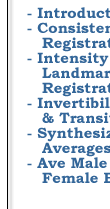
 |
|||||
 |
|||||
Next: Transformation Properties Up: index Previous: index
Introduction
Knowing the pointwise correspondence between two anatomical images allows information [1] such as segmentations, structure names, function, geometric shape properties, etc., to be mapped from one image coordinate system to the other. This allows for creation of individualized anatomical atlases [2], probabilistic anatomical atlases [3,4], automatic segmentation [5,6], surgical planning [7], modality fusion [8,9], morphological analysis [10], synthesizing average anatomical images [11] and many other applications. The relevance or usefulness of the information produced by these applications depends on the degree that a biologically realistic correspondence1 can be determined in the absences of ``truth'' or a gold-standard. To date, a few gold-standards have been established for rigid registration [12] but there are none to our knowledge for nonrigid registration.
In the absence of a gold standard, we seek to establish the validity
of a registration algorithm by describing the properties that a set of
biologically realistic mappings or transformations should have. Specifically,
a set of biologically realistic transformations should satisfy the properties
of invertibility and transitivity. A pair of transformations from image
![]() -to-
-to-![]() and
and ![]() -to-
-to-![]() are said to be invertible if the composition of the two transformations
is the identity mapping. A set of transformations
are said to be invertible if the composition of the two transformations
is the identity mapping. A set of transformations ![]() is said to have the transitive property if the composition of transformations
from
is said to have the transitive property if the composition of transformations
from ![]() -to-
-to-![]() and
and ![]() -to-
-to-![]() equals the transformation from
equals the transformation from ![]() -to-
-to-![]() for all
for all
![]() . If the set of transformations
. If the set of transformations ![]() has the transitivity property, then the composition of transformations
from
has the transitivity property, then the composition of transformations
from ![]() -to-
-to-![]() ,
, ![]() -to-
-to-![]() , and
, and ![]() -to-
-to-![]() gives the identity mapping for all
gives the identity mapping for all
![]() . These properties allow the performance of a registration
algorithm to be established by measuring how well the transformations
it produces satisfy the invertibility and transitivity properties.
. These properties allow the performance of a registration
algorithm to be established by measuring how well the transformations
it produces satisfy the invertibility and transitivity properties.
The key observation of this work is that even though the gold standard transformation between two images is not known, it is possible to establish an evaluation criterion by specifying the properties that a set of related transformations determined from a collection of images should satisfy. In this way, the performance of an image registration algorithm is evaluated indirectly rather than directly.
Satisfying the invertibility and transitivity properties are necessary but not sufficient conditions for establishing whether or not a registration algorithm produces biologically meaningful transformations. For example, an algorithm that always produces the identity mapping satisfies both the invertibility and transitivity properties but does not produce biologically relevant correspondence mappings. Conversely, the invertibility property ensures that a point x in image A that corresponds to a point y in image B implies that there exists a mapping from x to y and a mapping from y to x. Likewise, the transitive property ensures that if points x, y, and z correspond to each other in images A, B, and C, respectively, then there is a unique mapping from A to B to C to A.
Until recently, the invertibility property of a set of nonrigid transformations
has been virtually ignored. The idea of consistency of three transformations
was first introduced in 1996 by Freebourough et al. [13]. In 1998, Woods et al. [14] proposed a method for for computing pairwise
consistent transformations between a set of homogeneous anatomical images
using a
![]() linear transformation model. Also in 1998, Thirion[15] proposed a nonrigid image registration
algorithm that computed pairwise consistent transformations. In 1999,
we introduced the consistent linear-elastic image registration algorithm[16,17] which specifically enforced
the pairwise inverse consistency between transformations. In 2000, Holden
et al. [18] used the consistency of three transformations
to evaluate different voxel similarity measures. A related discussion
on the importance of invertibility and transitivity of transformations
for matching surfaces is presented by Thompson and Toga[19] in which the properties of transitivity
and symmetry are used to motivate a ``homothetic'' or uniformly-parameterized
matching of surfaces.
linear transformation model. Also in 1998, Thirion[15] proposed a nonrigid image registration
algorithm that computed pairwise consistent transformations. In 1999,
we introduced the consistent linear-elastic image registration algorithm[16,17] which specifically enforced
the pairwise inverse consistency between transformations. In 2000, Holden
et al. [18] used the consistency of three transformations
to evaluate different voxel similarity measures. A related discussion
on the importance of invertibility and transitivity of transformations
for matching surfaces is presented by Thompson and Toga[19] in which the properties of transitivity
and symmetry are used to motivate a ``homothetic'' or uniformly-parameterized
matching of surfaces.
The invertibility and transitivity properties of transformations computed using a unidirectional and inverse consistent linear-elastic registration algorithm are compared in this paper. Section 2 gives the mathematical definitions of invertibility and transitivity and Section 3 summarizes the unidirectional and consistent linear-elastic registration algorithms. The results of our invertibility and transitivity analysis are presented in Section 4 for 2D computer generated phantoms, 3D CT data and 3D MRI data. Finally, the summary and conclusions are described in Section 5.
Next: Transformation Properties Up: index Previous: index Gary E. Christensen 2002-07-04
Copyright © 2002 • The University of Iowa. All rights reserved.
Iowa City, Iowa 52242
Questions or Comments: gary-christensen@uiowa.edu